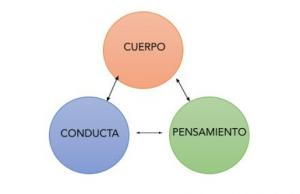Experiential avoidance disorder: symptoms, causes, and treatment
Suffering, as unpleasant and painful as it may be, is part of human existence. It is something that, like life and death or love and hate, is present to a greater or lesser extent in each one of us.
In case of suffering too much it is logical and totally indicated that each one looks for methods to reduce this feeling, However, it sometimes happens that the more you try to avoid pain, the more you think about it and, as a side effect, the more you suffers.
This may be a sign that you are suffering experiential avoidance disorder, a psychological condition in which all attempts to avoid what produces an aversive sensation ironically imply that more is thought about it. Let's see in more detail its characteristics and what therapies are used to treat it.
- Related article: "Acceptance and Commitment Therapy (ACT): principles and characteristics"
What is Experiential Avoidance Disorder?
Experiential avoidance disorder is a disorder in which the person avoids or escapes an aversive experience. Negative feelings, emotions or thoughts are not accepted, focusing all forces on fleeing from them, but without allowing himself to continue enjoying life because the experiences have not yet been eliminated aversive.
Among people who suffer from it, it is very common to hear phrases such as' I need to be well to be able to do things ',' I can't work well if I'm not happy 'or' I can't enjoy exercising while thinking about what bad'. This is a sample of how the person feels a great discomfort due to rumination of it and, in addition, he is not able to obtain pleasant sensations because he does not allow them to occur or does not go in search of them.
The disorder is verbal in nature, that is, is determined by the verbal disposition of the person to classify what is seen as good or bad, based on private events, with physical and verbal characteristics, in addition to negative evaluations, responses to events and their life experiences.
Problems related to experiential avoidance can appear when you begin to act rigidly to eliminate or avoid the internal experience, being a very present factor in the way in which the person. This, at first, will be done consciously but, when a certain time has passed, the person will incorporate this avoidance into their repertoire of behaviors, which will become automatic.
Efforts to avoid the unpleasant sensation interfere with emotional responses, in addition to endangering aspects considered important and pleasant for the person, such as their hobbies, personal relationships, work and others.
Is avoidance always bad? Characteristics of the disorder
In short, experiential avoidance is trying to avoid unpleasant thoughts, feelings, and emotions, with the intention of not experiencing them. However, this should not be understood to mean that avoiding something unpleasant is necessarily a psychological disorder. The human being constantly avoids phenomena that are not pleasant to him, and it is usually a positive thing.
Avoiding something that could be harmful is, in truth, an adaptive resource, since something is fleeing that can damage the physical or mental integrity of the person. For example, being in the field, if you see a bee hovering near where we are, that is fine. move away a bit because, although he has not shown intention to attack us, we do not want him to end doing it.
Nevertheless, avoidance becomes a problem if doing so involves a great cost to the person, both in terms of their state of mind and their physical well-being. It is possible that, to avoid the unpleasant sensation, behaviors are carried out that are satisfying in the short term, but that are harmful in the long term. This can be summed up in a simple formula: avoidance is a bad thing when the harm of avoiding is greater than the harm that is avoided.
Symptoms
The proposed diagnostic criteria for this disorder are the following:
- Constant feelings that revolve around feeling bad.
- The mind becomes obsessed with coping with discomfort.
- Great efforts to control negative feelings, emotions and thoughts.
- Rigid belief that it cannot be enjoyed without first eliminating all discomfort.
- Wait until you are well to fully function as a person.
Take the case of a person who has just suffered the loss of a loved one. The normal thing is to go through the mourning phase, which is sad and undesirable, but totally normal after the death of someone who has been loved. In this case, the person would be showing behaviors related to experiential avoidance if instead of accept the situation or seek psychological help to overcome the process, consumed alcohol to escape the reality. You are running the risk of becoming an alcoholic.
- You may be interested: "Grief: coping with the loss of a loved one"
Possible causes
The main cause that has been hypothesized to explain this little-known disorder is related to the personality of the person who suffers it. It has been suggested that the origin of experiential avoidance is psychological inflexibility when dealing with one's own discomfort, both trying to escape from it and avoiding it.
Not being able to adjust to the fact that the suffering is going to be there, and having the rigid idea that to enjoy first it is necessary to eliminate all unpleasant sensations, the person's life life revolves around avoidance.
The individual closes in on the experience of painful emotions, sensations and thoughts and is not able to continue with their daily tasks or her hobbies. By continuing to think about the bad and not looking for good experiences, you get into an increasingly damaging loop. If you suffer from depression or anxiety, this is even worse.
- You may be interested: "Rumination: the annoying vicious circle of thought"
Consequences of experiential avoidance
As we were already saying, if the person who suffers from this disorder also suffers from another condition psychological negative, such as anxiety and depression, the situation can be especially serious.
Disorders whose symptoms are these psychological problems should be treated professionally. If the person who is suffering from them is carrying out efficient strategies to increase her well-being, that is something positive and totally appropriate. To the extent possible, mood and anxiety disorders can be overcome.
However, during the recovery process, the person must be aware that he will experience a certain degree of discomfort, and must accept this while the therapy is being carried out. Waiting for all the discomfort to go away to start doing beneficial behaviors on an emotional level, such as hobbies, is a problem that makes it difficult that therapy can continue, as there are no positive reinforcements that make the person more and more motivated and overcome their problems psychological.
Not accepting the discomfort of these problems, avoiding them or escaping from them, implies the following situations:
- Try to control the discomfort, which makes you more aware of it and, in turn, increases.
- The day to day becomes a constant fight against that discomfort, downplaying reinforcers or pleasant sensations.
These two avoidance behaviors have, in turn, several social implications in the person's life. The person gradually isolates himself from his circle of friends and even family. It is expected to be fine to go to the movies, to the gym, to go back to school, to go to work... This can stretch for a long time, reaching up to months and years.
Treatment: Acceptance and Commitment Therapy
As we already mentioned, suffering is part of anyone's life and, although it is always It is preferable to find a way to reduce or eliminate the cause of this discomfort, sometimes this option is not possible. There are certain thoughts, sensations, and emotions that cannot simply cease to exist. and, therefore, finding ways to make them stop feeling is impossible.
The best thing in these cases is to accept that these experiences are going to be lived, no matter how unpleasant they may be. Focusing on eliminating them can be a huge waste of energy and too much attention, making the path to a vital goal difficult for the person to feel good about.
Acceptance and Commitment Therapy seeks to make the person aware that they actually suffer a certain discomfort, but that must accept it, not run from it. There are aspects in life that are not going to disappear and waiting for them to be solved or running away from them are not good strategies if they are detrimental to the life in general of the person.
Therapists use different strategies to treat the symptoms associated with experiential avoidance disorder, such as Mindfulness, therapeutic metaphors and cognitive de-fusion. In addition, the focus of therapeutic action is also focused on the restoration of the most important aspects for the person, such as their hobbies, work, academic, social and family life.
It is intended to get you to stop fighting your discomfort and, instead, focus on carrying out actions that imply true well-being, that will make you have a life more and more rich in pleasant experiences and that you come to accept that being bad does not mean not being able to enjoy.
A final thought
In developed societies, especially in the Western world, the philosophy of always being well has been promoted, of enjoying all activities, both leisure and work. We are not allowed to feel bad, and any negative feeling is seen as a symbol of weakness or as a cause for great concern. Being sad, crying, experiencing unpleasant moments are undoubted parts of life, but it seems to be that experiencing them is something that is almost forbidden and whoever experiences them fights so that no one gives bill.
Feeling good has become a fundamental aspect in the successful person model It has been tried to impose both by the media and by more personal environments, such as family or school. You are always happy is seen as something that is synonymous with being a fully adapted person, despite the fact that this belief is totally wrong.
Euthymia, that is, living all kinds of feelings within limits considered healthy, is a evolutionary mechanism, which allows the survival of the person in addition to the adaptation of it in terms social. There are days when we feel good, and others not so much. The days when you are sad you are like this for some reason that, if you think about it, allows us to learn from our mistakes or based on some situation that we did not like. We live in the moment, and it allows us to continue living.
If we become obsessed with being perfectly happy, focusing on avoiding the negative feeling or thought and procrastinating enjoyable experiences we could be having right now, isn't it like we're actually sabotaging our own happiness?
Bibliographic references:
- Luoma, J. B., Hayes, S. C., & Walser, R. D. (2007). Learning ACT: An acceptance and commitment therapy skills-training manual for therapists. Oakland, CA, US: New Harbinger Publications.
- Hayes, Steven C.; Spencer Smith (2005). Get Out of Your Mind and Into Your Life: The New Acceptance and Commitment Therapy. New Harbinger Publications



